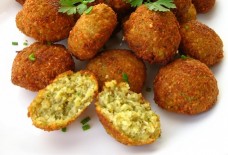Mediterranean Cooking from the Garden with Linda Dalal Sawaya: Favas (Ful)—an Ancient Mediterranean Staple
green fava beans © linda dalal sawaya 2015
You may have seen them in this week’s farmers markets, as fava beans do well in the spring as they have in the Mediterranean for thousands of years. Native to North Africa and Southeast Asia, the fresh and dried beans are a major source of protein, and as nitrogen-fixing legumes, are an excellent overwintering crop that can be tilled back into the soil to enrich it before planting summer crops. Easy-to-grow fava beans are planted all over the world meaning one can find a culinary array of recipes for preparing them.
Last fall, I spent a joyous month in Lebanon and yet was not home to plant favas for my winter garden. This morning at my local Portland food co-op, I found lovely fresh, locally grown beans and was surprised and could not resist the fava bean tops piled high even though I’ve never eaten them having grown favas for years. Much like pea shoots, which became popular beyond Asian restaurants, fava greens appear frequently on upscale menus—amusingly as fava beans have long been considered a poor man’s food. The greens are similar in texture to spinach, with the nutty flavor of the legume. I discovered fragrant, tender, sweet blossoms tucked into the leaves—a delightful find.
fava bean tops in my food co-op © linda dalal sawaya 2015
First I snipped off and set aside the leaves from the thick, square hollow stems that first went into my sauté with olive oil and onions. I then added the roughly chopped greens, sliced garlic, and red chili pepper flakes, tossing quickly over a medium high heat to keep a bright green color before serving.
sautéeing fava bean stems © linda dalal sawaya 2015
sautéeing fava bean tops with garlic and onions © linda dalal sawaya 2015
Then I chopped the youngest and most tender whole green favas and added them to another pan with olive oil and onions to sauté before adding a special Japanese brown rice given to me by a friend. Then I did a crazy thing after adding the rice: I added coconut water and some pink kombucha tea that I made recently using a pomegranate tea instead of adding vegetable stock or water. The pomegranate kombucha turned the rice pink, and was a lovely acidic offset to the sweet alkaline coconut water. It was a lucky experiment and was a fabulous take on our traditional Arabic ful ou riz—favas and rice.
whole green fava beans sautéed with onions © linda dalal sawaya 2015
Typical Middle Eastern uses of fresh fava beans are with rice, in stews either vegetarian or meat based, sautéed and drizzled with garlic, oil, and lemon juice, and in salads—accompanied by lemon and garlic. The Lebanese and other Arabs love these young, fresh beans raw, straight out of the pod, as an appetizer. Young tender beans are cooked with their pods topped, tailed, and strings removed; while more mature beans are shelled with the inner coating of the bean removed by blanching, or not.
green fava beans cooking with rice © linda dalal sawaya 2015
ful ou riz © linda dalal sawaya 2015
With the shelled beans, I made a bright green fava bean paté simply seasoned with garlic, lemon juice, salt, and a dash of cayenne pepper after blanching the beans. It tastes great and is a wonderful, unusual appetizer dip or spread on bread.
blanched fava beans © linda dalal sawaya 2015
green fava beans with skins slipped off © linda dalal sawaya 2015
green fava bean pate © linda dalal sawaya 2015
Levantine ful mdammas—a breakfast favorite, the now well-known falafel, Moroccan bessara—a hearty dip similar to hommous, soups, and stews are cooked using dried fava beans and are eaten year round. Iraqi bagilla, a stew, is also made by Egyptians and Iranians. Italians love favas and prepare them with pastas, risottos, frittatas, and as pesto. Japanese style grilled fava beans are a great substitute for edamame, drizzled with olive oil, and dusted with lemon zest, and salt and make a wonderful appetizer or accompaniment to fish or other grilled foods.
If you are not growing your own fava beans, check your local farmers market or food co-op to find this protein-rich, ancient culinary treasure in season now, with its unmistakeable nutty and earthy flavor. Sahtein, and happy cooking!
—Linda Dalal Sawaya is a Portland artist, cook, Master Gardener, and author of Alice’s Kitchen: Traditional Lebanese Cooking
Remember, as my mother Alice said, “If you make it with love, it will be delicious!”
all photos and story © linda dalal sawaya 2015


